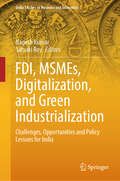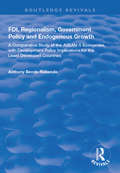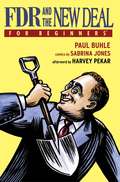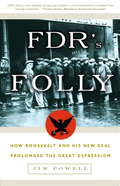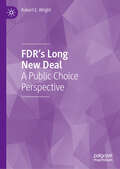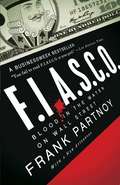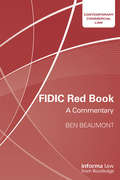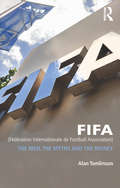- Table View
- List View
FDI, MSMEs, Digitalization, and Green Industrialization: Challenges, Opportunities and Policy Lessons for India (India Studies in Business and Economics)
by Nagesh Kumar Satyaki RoyThis book presents fresh research on how Foreign Direct Investments (FDI), Micro, Small and Medium Enterprises (MSMEs), patterns of clustering, digitalization and innovation policies, interact and influence India’s industrialisation and its greening or sustainability. As India seeks to accelerate its process of industrialization especially focusing on the manufacturing sector, different interactions between agents of industrialization need to be understood better through evidence-based research. The volume through its 17 original contributions, focuses on three broad interrelated themes: FDI, export performance, innovation and environmental sustainability; growth, competitiveness and spatial distribution of MSMEs concerning access to finance, digitalisation and sustainability; and, green technology, circular economy and challenges towards clean transition and green industrialization. Research presented in this book does not see industrialization as an isolated process from globalization and appreciates the need to act upon specific impacts of foreign trade and investments. With a focused and futuristic approach towards industrialisation in India, it provides rigorous evidence-based treatment of complex interactions using secondary and primary sources of data deploying appropriate analytical techniques. In light of empirical findings, each chapter comes up with policy lessons for industrial strategy. Shedding new light and evidence, this book makes an important contribution by helping to generate a better understanding of the process of green industrialization and how it can be fostered to create inclusive and sustainable prosperity. It will be an invaluable resource for policymakers, analysts, researchers and students of industrial and environmental economics.
FDI, Regionalism, Government Policy and Endogenous Growth: A Comparative Study of the ASEAN-5 Economies, with Development Policy Implications for the Least Developed Countries
by Anthony Bende-NabendePublished in 1999, this text investigates whether FDI caused spill over effects which have led to the economic growth of the ASEAN-5 economies, and if that it so, whether the ASEAN Preferential Trade Agreement (APTA) had a significant effect in attracting FDI to the region. It takes into account the different levels of economic development of the countries under analysis. The results from the structural (static) model suggest that FDI has stimulated economic growth through the human factors followed by technology transfer, international trade, and learning by doing, and that the formation of APTA had a lagged influence on FDI inflows into the advantage of the more developed member countries and the disadvantage of the less developed countries. Those from the multiplier (dynamic) effects analysis demonstrate that whereas the impact is immediate in the more developed, politically stable and foreign investment friendly economies, there is a time lag in those economies which are less developed and more hostile to FDI. The analysis presents an empirical comparison of how the level of economic development affects the interaction of FDI, regionalism and economic growth.
FDI, Technology and Innovation
by K. Narayanan N. S. SiddharthanThis book concentrates on major changes that are now taking place in the fields of technology, foreign direct investment (FDI), trade and development strategies, with a particular focus on India. Arguably, these changes are likely to differ from those that the world has experienced over the past few decades; in particular, now that many countries have globalised their economies. The book begins by reviewing the changing pattern of FDI flows and technologies among developed and emerging economies, before identifying the determinants of this change by presenting specific studies on Indian industries. It then addresses key questions such as: How are knowledge spillover mechanisms operationalised, and what are the implications of the internationalisation of the IPR process? The role of FDI is also analysed in order to make policy recommendations for fostering innovation in emerging economies like India. The respective chapters examine the process through which technological paradigm and trajectory shifts are taking place, the factors that facilitate such shifts, the changing pattern of FDI, and the shifting focus of international trade and development strategies – four broad themes that are interrelated and mutually reinforcing. The book offers important takeaways for all social scientists, technologists and business schools interested in Indian studies; it will also benefit researchers whose work involves development economics, industrial organisation and technology, and the economy / society interface.
FDR and the New Deal for Beginners®
by Paul BuhleA profusely illustrated, popularly-written volume with original comic art,FDR and The New Deal For Beginnerswill shed new light upon a story now regaining visibility thanks to the recent economic crisis and prominent reformer, President Obama, in the White House. The history of the precedent-making FDR administration through the bitter economic depression, with expansive programs empowering artists and working people, comes alive as the grandest social experiment in the history of American democracy. ...
FDR's Alphabet Soup: New Deal America, 1932-1939
by Tonya BoldenFDR’S New Deal, which followed the 1929 stock market crash, was a hugely influential moment in the history of the United States, encompassing everything from the arts to finance, labor to legislation, and some think it helped bring the country out of the Great Depression. Here, Tonya Bolden, writing in her trademark accessible style, creates a portrait of a time that changed American history both then and now. <P><P> FDR’s First 100 Days and how the United States was changed by it then are closely examined, especially now. The 2009 financial situation is eerily mirrored by that of the late 1920s, and this is a perfect book to help teens understand history and its lasting impact on current events.
FDR's Folly: How Roosevelt and His New Deal Prolonged the Great Depression
by Jim PowellThe Great Depression and the New Deal. For generations, the collective American consciousness has believed that the former ruined the country and the latter saved it. Endless praise has been heaped upon President Franklin Delano Roosevelt for masterfully reining in the Depression&’s destructive effects and propping up the country on his New Deal platform. In fact, FDR has achieved mythical status in American history and is considered to be, along with Washington, Jefferson, and Lincoln, one of the greatest presidents of all time. But would the Great Depression have been so catastrophic had the New Deal never been implemented?In FDR&’s Folly, historian Jim Powell argues that it was in fact the New Deal itself, with its shortsighted programs, that deepened the Great Depression, swelled the federal government, and prevented the country from turning around quickly. You&’ll discover in alarming detail how FDR&’s federal programs hurt America more than helped it, with effects we still feel today, including:• How Social Security actually increased unemployment• How higher taxes undermined good businesses• How new labor laws threw people out of work• And much moreThis groundbreaking book pulls back the shroud of awe and the cloak of time enveloping FDR to prove convincingly how flawed his economic policies actually were, despite his good intentions and the astounding intellect of his circle of advisers. In today&’s turbulent domestic and global environment, eerily similar to that of the 1930s, it&’s more important than ever before to uncover and understand the truth of our history, lest we be doomed to repeat it.
FDR’s Long New Deal: A Public Choice Perspective
by Robert E. WrightDuring his presidency, FDR led the American public to believe that the US government could set policy that would transform the economy. This book argues that this assumption, which ultimately became embedded into the general American psyche, has impacted our economy today in more ways than one. Robert E. Wright breaks down the negative societal impact of the New Deal throughout this book. The chapters highlight the lasting influence of these policies, providing new perspectives and never-before-seen archival research related to FDR's policies. The book provides insight into how assumptions of governmental intervention in the economy have shifted the direction of the economy over time. It also dives into socioeconomic topics related to social justice, critiquing the New Deal in its original and historical contexts. Wright brings a long-term public-choice perspective to the New Deal, providing interdisciplinary insights into socioeconomic topics such as gender, race, and climate. The resulting book is ideal for those interested in economics, American history, law, and policy.
FIASCO: Blood in the Water on Wall Street
by Frank Partnoy"Applies an intelligent, clinical eye to [an] excruciatingly complex corner of the financial world." --New York Times A classic of its kind, Frank Partnoy's best-selling FIASCO takes readers inside the rollicking world of derivatives on Wall Street during the mid-1990s. The book tracks Partnoy's success as a young Morgan Stanley employee who quickly becomes steeped in a culture that treats client as targets to be "blown up" or have their faces "ripped off." A decade later FIASCO remains one of the most damning and prescient pictures of the speculative frenzies that grip Wall Street and the victims they can leave in their wake. In Partnoy's case they include well-publicized losses at Orange County, Barings, and Procter & Gamble, among others. A new epilogue written for this edition brings Partnoy's story--as well as the story of derivatives--up to the present.
FIDIC Red Book: A Commentary (Contemporary Commercial Law)
by Ben BeaumontWritten by a member of the FIDIC President’s List of Adjudicators, this detailed and critical commentary on the FIDIC Red Book provides authoritative guidance and recommendations for best practice. Focusing on each Clause of the Condition of Contract, this book identifies pitfalls and logistics issues associated with its enforcement and ancillary processes, to give readers an advantage when operating with the FIDIC Red Book. Intended to promote the best use and growth of FIDIC, this guide will be essential for all users of the FIDIC Red Book, be they contractors, lawyers, engineers, students training to join these industries or any professional involved in the resolution of disputes involving the FIDIC Red Book.
FIELD Immersion 2022: Albuquerque, New Mexico
by Alberto F. Cavallo Stacy StraabergIndustry and Background Note
FIELD Immersion 2022: Baltimore, Maryland
by Zeke Gillman Hakeem Belo-OsagieIndustry and Background Note
FIELD Immersion 2022: Birmingham, Alabama
by Julia Kelley Monique Burns ThompsonIndustry and Background Note
FIELD Immersion 2022: Chattanooga, Tennessee
by Caroline Elkins Tom QuinnIndustry and Background Note
FIELD Immersion 2022: Lawrence, Massachusetts
by Tom Quinn Laura AlfaroIndustry and Background Note
FIELD Immersion 2022: Louisville, Kentucky
by Leonard A. Schlesinger Alexis LefortIndustry and Background Note
FIELD Immersion 2022: Pittsburgh, Pennsylvania
by Vikram Gandhi Zeke GillmanIndustry and Background Note
FIELD Immersion 2022: Salt Lake City, Utah
by Kerry Herman Alan MacCormackIndustry and Background Note
FIELD Immersion 2022: San Antonio, Texas
by Tarun Khanna James Barnett Sara L. FleissIndustry and Background Note
FIELD Immersion 2022: Tulsa, Oklahoma
by Annelena Lobb Prithwiraj Raj ChoudhuryIndustry and Background Note
FIELD Immersion: Orchestrating a Compelling Presentation
by Jill AveryThis note was written to help you organize and orchestrate your FIELD Immersion final project presentation to your Project Partners. It is designed to illustrate ways to make your final presentation persuasive, inspiring, and powerful - a presentation with presence. Orchestrating a compelling presentation involves a three stage process of conceiving, visualizing, and presenting that begins with understanding and empathizing with your audience, leveraging your emotional intelligence to craft a persuasive message that addresses their needs. Developing an engaging story using storytelling techniques can help you design a presentation that will resonate with your audience. Translating your story into visuals with impact and delivering it with presence is critical to connecting with your audience in an authentic and powerful way.
FIFA (Fédération Internationale de Football Association): The Men, the Myths and the Money
by Alan TomlinsonFounded in 1904 by representatives of the sporting organisations of six European nations then expanding into the Americas, Asia and Africa FIFA has developed to become one of the most high profile and lucrative businesses in the global consumer and cultural industry. Recent years however have been characterised by a series of crises leaving the organisation open to critique and exposure, and creating a soap operatic narrative of increasing interest to the global media. In this critical new account of one of the world’s most important sporting institutions, Professor Alan Tomlinson investigates the history of FIFA and the underlying political dynamics characterising its growth. The book explores the influence of the men who have led FIFA, the emergence of the World Cup as FIFA’s exclusive product, FIFA’s relationships with other federations and associations, the crises that have shaped its recent history, and the issues and challenges that are likely to shape its future. Particular focus is given to selected moments in the post- Havelange administration and the way in which FIFA, its current president Joseph Blatter and some key close colleagues have responded to and survived successive scandals. The book provides a foundation for understanding the growth and development of what is widely accepted as the world’s most popular sport; sheds light on the shifting politics of nationalism in the post-colonial period; and reveals the opportunistic forms of personal aggrandizement shaping an increasingly media-influenced and globalizing world in which international sport was both a harbinger and an early reflection of these trends and forces. Fascinating and provocative, this is essential reading for anybody with an interest in soccer, sport and society, sports governance, or global organisations.
FIFA and The World Cup: The Future of Football
by Anita Elberse Howard Johnson Oliver BandShould FIFA host its biggest event-the FIFA World Cup-every two years instead of every four, as it has been doing since the event's inception in the 1930s? In September 2021, Gianni Infantino, the president of the International Federation of Association Football (FIFA), addresses representatives of the 211 national associations that are members of football's highest-level governing body, from a conference room in FIFA's headquarters in Switzerland. The members have convened to discuss proposed reforms spearheaded by former coach Ars ne Wenger, FIFA's Chief Football Officer, who is seated next to Infantino. News of the planned reforms already have sent shockwaves through the world of football. For instance, the president of football's European confederation, UEFA, has referred to a biennial World Cup as a "killer" and vowed to boycott the idea. The president of the Spanish league, one of football's top three domestic leagues, has dismissed the plans as "a threat not just to domestic football leagues but to the overall tradition of world football." Are the proposed reforms-all part of a 'Future of Football' project designed to reshape the sport-the right bet for FIFA? And if so, what can the governing body do to guide the process along the right path?
